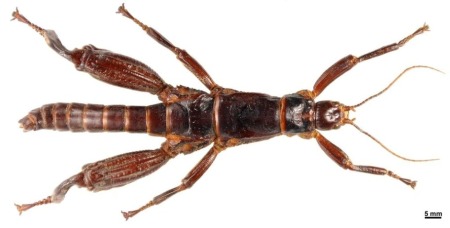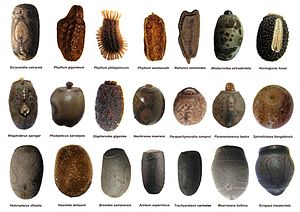
Phasmida dryococelus, among the heaviest living insects known to science, shown here roughly to scale if you're using a standard sized computer monitor. Image courtesy of NPR
It’s been quite a week for giant insects. First we hear of extinct monster fleas with a hankering for Jurassic blood. Now an unexpected find; once thought to be extinct “tree lobsters” have been successfully collected and bred in captivity, giving them a chance to beat nature’s wholesale grim reaper.
A few years ago scientists were amazed to find two breeding pairs of the giants, classified as Phasmida dryococelus, on a remote volcanic spike looking almost like a Fairy Castle rising spike-like the sea off Australia’s coast. Phasmida tend to be huge, and they lay a photogenic arrays of eggs, some of which bear an uncanny resemblance to hand-crafted miniature pottery.
These new found insects are actually close relatives of the familiar, cleverly camouflaged walking stick we outdoors-y boys and girls liked to collect as kids, and we grown up science bloggers find useful to illustrate natural selection. With only two known breeding pairs barely surviving in a single row of bushes on a tiny shard of an island infested by wild rats, the future for the entire species was grim. It was clear action had to be taken. The first captured breeding pair died in captivity with no offspring. So scientists took the last two back to well equipped facilities under the watchful eye of Phasmid experts and carefully nurtured them, at one point even treating a dietary deficiency that left the lone female on her little death-bed. That biological Hail Mary was a success.
From that last initial pair, hundreds have now hatched and grown to maturity. This species is ready to be reintroduced, somewhere. But where and how they should be allowed to make a go of it is a subject of some debate.


“Giant insects once thought extinct now in successful captive breeding program” – which explains where the GOP got its current crop of Presidential contenders from…
lordship
You got something against insects?
Talk about a genetic bottleneck … wow.
Awesome story, but one small correction:
“And below those two, slithering into the muck, were more, and more … 24 in all. All gathered near this one plant.”
There were 24 insects left on Ball’s Pyramid. The reason they could only try to take 4 was because that’s what the Australian government thought would be safe.